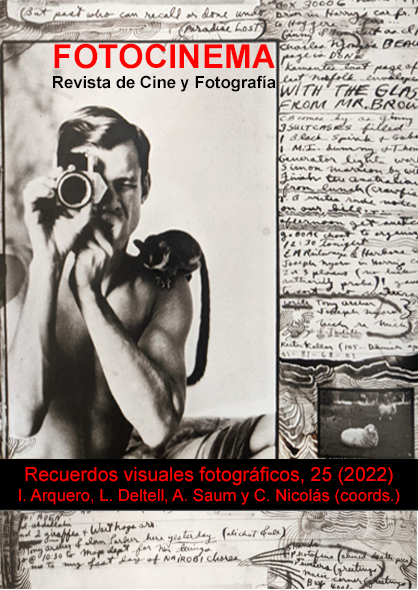Some tribulations of contemporary film analysis. Notes in the margins of Conexiones, un diálogo con Santos Zunzunegui (Asier Aranzubia, 2022)
DOI:
https://doi.org/10.24310/Fotocinema.2022.vi25.15136Keywords:
Film Analysis, Textual Analysis, Santos Zunzunegui, Asier Aranzubia, ConexionesAbstract
This paper is a subjective exploration of the place of film analysis in the contemporary Spanish academic world, taking as a starting point the book Conexiones, un diálogo con Santos Zunzunegui (Asier Aranzubia, 2022). For this purpose, an impressionistic essayistic style is used to deploy a series of theoretical suggestions on the evolution of film writing in the last four decades and on its corresponding transfer processes in the Spanish university. Special emphasis is placed on the difficulties that the current system of publish or perish exerts on new researchers and on the difficulties of access to accreditations. On the positive aspects, the figure of the teacher and the exercise of analysis as a method of knowledge transmission and reflection in the classroom for a correct reflection on the processes of meaning of the film are vindicated. Our text intends to explore the many successes of Aranzubia's book and to vindicate the legacy of Santos Zunzunegui in the contemporary panorama of film analysts in the Hispanic field.
Downloads
Metrics
References
Aranzubia Cob, A. (2002). Contracampo y el cine español. Boletín HIspano Helvético, 0, 75–89.
Aranzubia Cob, A. (2011). En busca de una brújula: La crítica y la cinefilia. Cahiers Du Cinema. España, 45, 83.
Aranzubia Cob, A. (2022). Conexiones. Un diálogo con Santos Zunzunegui. Shangrila.
Aranzubia Cob, A., Arocena, C., Carrera, P., & Zumalde, I. (2012). Composiciones de lugar: ensayos in honorem Santos Zunzunegui en su 65 aniversario. Biblioteca Nueva.
Català, J. M. (2019). La puesta en imágenes. Conceptos de dirección cinematográfica. Shangrila.
Losilla, C. (2021). Deambulaciones. Diario de cine, 2019-2020. Muga.
Marzal-Felici, J. (2021). Propuestas para el estudio de las imágenes en la era de la posverdad. El Profesional de La Informacion, 30(2).
Monroy, V. (2020). Contra la Cinefilia. Historia de un romance exagerado. Clave Intelectual.
Montiel, A. (2002). El desfile y la quietud (Análisis fílmico versus Historia del Cine). Generalitat Valenciana.
Nieto Ferrando, J., & Aranzubia Cob, A. (2020). Las revistas académicas de estudios fílmicos. Una cartografía. Secuencias, 51, 11–38.
Nieto Ferrando, J., & Monterde, J. E. (2018). La prensa cinematográfica en España (1910-2010). Shangrila.
Palacio, M., & Mejón, A. (2020). Historiografía y capital simbólico de los estudios en Comunicación, Cine y Televisión en España. El Profesional de La Información, 29(4). https://doi.org/10.3145/epi.2020.jul.42
Planes Pedreño, J. A. (2017). La crítica cinematográfica de Ángel Fernández-Santos. Shangrila.
Rodríguez Serrano, A., Palao Errando, J. A., & Marzal Felici, J. J. (2019). Los estudios fílmicos en el contexto de las ciencias sociales: un análisis de autores, objetos y metodologías en las revistas de impacto españolas (2012–2017). BiD: Textos Universitarios de Biblioteconomía y Documentación, 43.
Rosenbaum, J. (2010). Goodbye Cinema, Hello Cinephilia: Film culture in transition. The University of Chicago Press.
Rosenbaum, J., & Martin, A. (2011). Mutaciones del cine contemporáneo. Errata Naturae.
Talens, J., & Zunzunegui, S. (2007). Contracampo: Ensayos sobre Teoría e Historia del Cine. Cátedra.
Zafra, R. (2017). El Entusiasmo?: precariedad y trabajo creativo en la era digital. Anagrama.
Zumalde, I. (2002). Los Placeres de la vista?: mirar, escuchar, pensar. Institut Valencià de Cinematografia Ricardo Muñoz Suay.
Zumalde, I. (2006). La Materialidad de la forma fílmica?: crítica de la (sin)razón postestructuralista. Euskal Herriko Unibertsitatea. Argitalpen Zerbitzua.
Zumalde, I. (2011). La Experiencia fílmica?: cine, pensamiento y emoción. Cátedra.
Zunzunegui, S. (2007). Acerca del análisis fílmico: el estado de las cosas. Comunicar: Revista Científica Iberoamericana de Comunicación y Educación, 29(15), 51–58.
Zunzunegui, S. (2017). Bajo el signo de la melancolía: Cine, desencanto y aflicción. Cátedra.
Zunzunegui, S. (2021). Imagen sobre imagen: Mis historias de cine I. Shangrila.
Zunzunegui, S. (2022). Profundidad de campo: Mis historias de cine II. Shangrila.
Zunzunegui, S., & Zumalde, I. (2018). La era del saber fungible. En Investigar en la era neoliberal. Visiones críticas sobre la investigación en comunicación en España (pp. 55–70). Universitat Pompeu Fabra, Universitat Autònoma de Barcelona, Universitat Jaume I y Universitat de València, Col.lecció Aldea Global.
Downloads
Published
How to Cite
Issue
Section
License
All contents published in Fotocinema Revista científica de cine y fotografía are protected under the Creative Commons Attribution-NonCommercial-ShareAlike 4.0 International (CC BY-NC-SA 4.0) license. All about this license is available in the following link: <http://creativecommons.org/licenses/by-nc-sa/4.0>
Users can copy, use, redistribute, share and exhibit publicly as long as:
- The original source and authorship of the material are cited (Journal, Publisher and URL of the work).
- It is not used for comercial purposes.
- The existence of the license and its especifications are mentioned.
There are two sets of authors’ rights: moral and property rights. Moral rights are perpetual prerogatives, unrenounceable, not-transferable, unalienable, imprescriptible and inembargable. According to authors’ rights legislation, Fotocinema. Revista científica de cine y fotografía recognizes and respects authors moral rights, as well as the ownership of property rights, which will be transferred to University of Malaga in open access. The property rights are referred to the benefits that are gained by the use or the dissemination of works. Fotocinema. Revista científica de cine y fotografía is published in an open access form and it is exclusively licenced by any means for doing or authorising distribution, dissemination, reproduction, , adaptation, translation or arrangement of works.
Authors are responsable for obtaining the necessary permission to use copyrighted images.













13.png)



